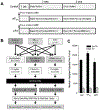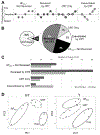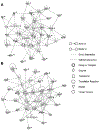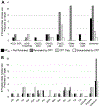Phospho-Proteomic Analysis of Cardiac Dyssynchrony and Resynchronization Therapy
- PMID: 30129105
- PMCID: PMC6417799
- DOI: 10.1002/pmic.201800079
Phospho-Proteomic Analysis of Cardiac Dyssynchrony and Resynchronization Therapy
Abstract
Cardiac dyssynchrony arises from conduction abnormalities during heart failure and worsens morbidity and mortality. Cardiac resynchronization therapy (CRT) re-coordinates contraction using bi-ventricular pacing, but the cellular and molecular mechanisms involved remain largely unknown. The aim is to determine how dyssynchronous heart failure (HFdys ) alters the phospho-proteome and how CRT interacts with this unique phospho-proteome by analyzing Ser/Thr and Tyr phosphorylation. Phospho-enriched myocardium from dog models of Control, HFdys , and CRT is analyzed via MS. There were 209 regulated phospho-sites among 1761 identified sites. Compared to Con and CRT, HFdys is hyper-phosphorylated and tyrosine phosphorylation is more likely to be involved in signaling that increased with HFdys and was exacerbated by CRT. For each regulated site, the most-likely targeting-kinase is predicted, and CK2 is highly specific for sites that are "fixed" by CRT, suggesting activation of CK2 signaling occurs in HFdys that is reversed by CRT, which is supported by western blot analysis. These data elucidate signaling networks and kinases that may be involved and deserve further study. Importantly, a possible role for CK2 modulation in CRT has been identified. This may be harnessed in the future therapeutically to compliment CRT, improving its clinical effects.
Keywords: CK2; dyssynchrony; heart failure; phosphorylation.
© 2018 WILEY-VCH Verlag GmbH & Co. KGaA, Weinheim.
Conflict of interest statement
The authors have declared no conflict of interest.
Figures





Similar articles
-
Cellular and Molecular Aspects of Dyssynchrony and Resynchronization.Heart Fail Clin. 2017 Jan;13(1):29-41. doi: 10.1016/j.hfc.2016.07.003. Heart Fail Clin. 2017. PMID: 27886930 Review.
-
Galphas-biased beta2-adrenergic receptor signaling from restoring synchronous contraction in the failing heart.Sci Transl Med. 2011 Sep 14;3(100):100ra88. doi: 10.1126/scitranslmed.3001909. Sci Transl Med. 2011. PMID: 21918105 Free PMC article.
-
Glycoproteins identified from heart failure and treatment models.Proteomics. 2015 Jan;15(2-3):567-79. doi: 10.1002/pmic.201400151. Epub 2014 Oct 9. Proteomics. 2015. PMID: 25141849 Free PMC article.
-
Circulating MicroRNA-30d Is Associated With Response to Cardiac Resynchronization Therapy in Heart Failure and Regulates Cardiomyocyte Apoptosis: A Translational Pilot Study.Circulation. 2015 Jun 23;131(25):2202-2216. doi: 10.1161/CIRCULATIONAHA.114.013220. Epub 2015 May 20. Circulation. 2015. PMID: 25995320 Free PMC article.
-
Assessment of mechanical dyssynchrony in cardiac resynchronization therapy.Dan Med J. 2014 Dec;61(12):B4981. Dan Med J. 2014. PMID: 25441737 Review.
Cited by
-
GSK-3β Localizes to the Cardiac Z-Disc to Maintain Length Dependent Activation.Circ Res. 2022 Mar 18;130(6):871-886. doi: 10.1161/CIRCRESAHA.121.319491. Epub 2022 Feb 16. Circ Res. 2022. PMID: 35168370 Free PMC article.
-
Inflammation and Heart Failure: Searching for the Enemy-Reaching the Entelechy.J Cardiovasc Dev Dis. 2023 Jan 4;10(1):19. doi: 10.3390/jcdd10010019. J Cardiovasc Dev Dis. 2023. PMID: 36661914 Free PMC article. Review.
-
Proteomics of the heart.Physiol Rev. 2024 Jul 1;104(3):931-982. doi: 10.1152/physrev.00026.2023. Epub 2024 Feb 1. Physiol Rev. 2024. PMID: 38300522 Free PMC article. Review.
-
Cardiac Resynchronisation Therapy and Cellular Bioenergetics: Effects Beyond Chamber Mechanics.Eur Cardiol. 2019 Apr;14(1):33-44. doi: 10.15420/ecr.2019.2.2. Eur Cardiol. 2019. PMID: 31131035 Free PMC article. Review.
-
Unlocking the Secrets of Mitochondria in the Cardiovascular System: Path to a Cure in Heart Failure—A Report from the 2018 National Heart, Lung, and Blood Institute Workshop.Circulation. 2019 Oct 1;140(14):1205-1216. doi: 10.1161/CIRCULATIONAHA.119.040551. Circulation. 2019. PMID: 31769940 Free PMC article. Review.
References
-
- Ghio S, Constantin C, Klersy C, Serio A, Fontana A, Campana C, Tavazzi L, Eur Heart J 2004, 25, 571. - PubMed
-
- Park RC, Little WC, O’Rourke RA, Circ Res 1985, 57, 706. - PubMed
-
- Burkhoff D, Oikawa RY, Sagawa K, American Journal of Physiology - Heart and Circulatory Physiology 1986, 251, H428. - PubMed
-
- Bader H, Garrigue S, Lafitte S, Reuter S, Jais P, Haissaguerre M, Bonnet J, Clementy J, Roudaut R, J Am Coll Cardiol 2004, 43, 248. - PubMed
-
- Auricchio A, Stellbrink C, Block M, Sack S, Vogt J, Bakker P, Klein H, Kramer A, Ding J, Salo R, Tockman B, Pochet T, Spinelli J, Circulation 1999, 99, 2993. - PubMed
Publication types
MeSH terms
Substances
Grants and funding
LinkOut - more resources
Full Text Sources
Other Literature Sources
Medical
Research Materials
Miscellaneous

